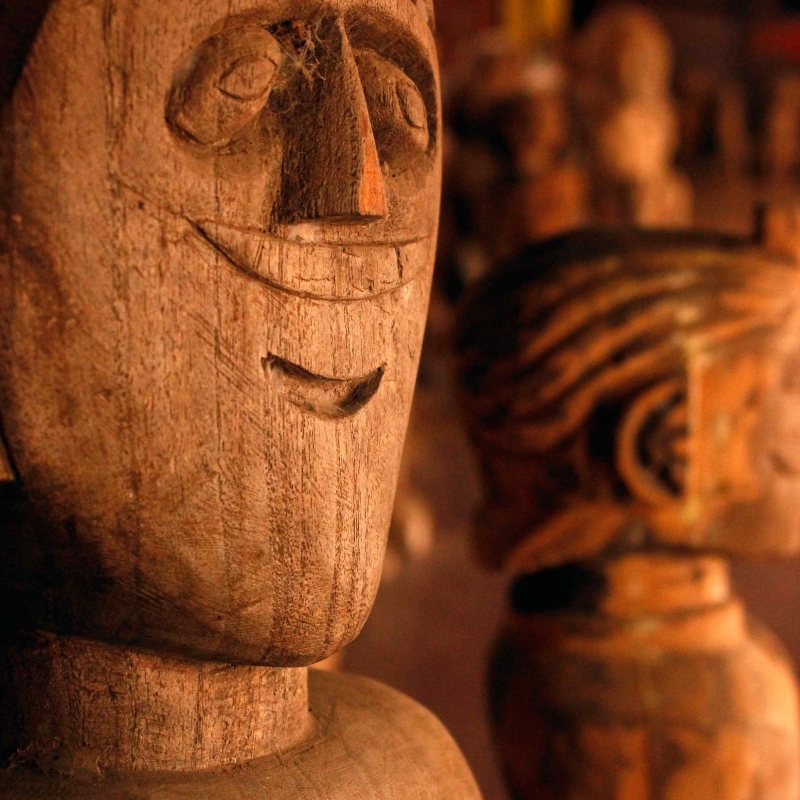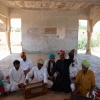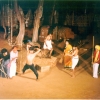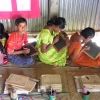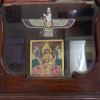Marginal Voices
The economic marginalisation of communities and their social and ecological vulnerability requires placing these in a relatively long-term historical perspective. Further, the strategies adopted for empowerment of the vulnerable community or fragile environment need to balance the immediate material context and the residual effects of histories of marginalisation or degradation.
This paper is based on a real-time development experiment carried out over a period of 18 years (1994 to 2011). The experiment relates to two social groups: the communities listed in official records as the Tribes of India, and the communities inscribed in colonial Indian history as ‘Criminal Tribes’ (these are not to be confused with the Tribes mentioned in the former category). These latter were ‘notified’ as ‘criminal’ during the colonial period (1871 Criminal Tribes Act [Devy 2007:14–20; Schwarz 2010:9–10]), and subsequently ‘denotified’ (1952–56) soon after Independence. They are now known as ‘Denotified and Nomadic Tribes’ (DNTs). The total population of tribes—also described in government terminology as Janjati, or known popularly as Adivasis (the indigenous)—is approximately 90 million; that of the communities notified during colonial times as ‘criminal tribes’ is projected at 60 million (Devy 2007), though an exhaustive census has not been carried out for the last 80 years. Both these tribes are being rapidly pauperised and stand at the tail end of the human development index within the Indian context. The figures for categories of disadvantage such as illiteracy, child mortality, food insecurity, indebtedness, non-profitable migration, non-access to credit, and to formal education and health care are uniformly higher than the overall national figures (Devy 2007:128).
Creating 'Criminals'
British colonial rule in India was not only a political and economic enterprise; it was also an experiment in restructuring a complex society. For the first two centuries of colonial contact, beginning with the arrival of the East India Company at Surat in 1600 to the establishment of the Asiatic Society in Bengal towards the end of the 18th century, the colonial imagination had great difficulty in understanding the complex weave of Indian society. Out of these difficulties arose many misconceptions and myths about communities and social conventions. At times these were as comical as the idea that India is a country of snake charmers and magicians. But in many instances the wrong reading of society resulted in untold human misery. This very same ‘knowledge’ formed the basis for formulating law during colonial times. The story of the communities known as ‘denotified’ is without doubt the most inhuman tale of the collapse of compassion.
During the 1830s, the colonial government appointed William Henry Sleeman (1788–1856) to prepare a list of instances of assaults on wayfarers in central India (Dash 2005: Chapters II & III). He took up this task with single-minded dedication and produced a voluminous list of violent episodes. The list would not have amounted to much had it not been for the turn of events during 1857 in central India. In the wake of the battles fought and lost by the Indian states, all isolated and potential groups of soldiers, and even those who were likely to be in the supply chain for them, came to be seen as candidates for the Sleeman list. Later, it was this list that became the basis of the 1871 Criminal Tribes Act (CTA).
Once the traditional occupations of the nomadic and semi-nomadic communities were brought under the scanner, the colonial government provided for their being officially declared ‘Criminal Tribes’. The government’s powers to declare a community ‘criminal’ were made arbitrary to the extent that the question of inclusion of a given community in the list was taken completely out of the judiciary’s purview. After this, even an attempt by any member of the community to move out of the district without informing the local authorities became a punishable offence. The act of questioning the notification in any form too came to be seen as a criminal offence. The colonial government’s right to detain such communities and to do whatever it decided to with their lives came to be seen as a lawful right and the duty of the government officials. The officials were charged with preparing Registers of Criminal Tribes, and once a register was prepared for a given district, even the very same official was not allowed to make any deletions in it. The nature of the declaration was made entirely non-negotiable and absolute. The victims of this draconian law were given no legal reprieve. The onus of proving that they were not criminal fell on them, but they were left with no rational argument since their being born in a certain community was itself seen as a crime. People belonging to these tribes had to spend their entire lives proving to the authorities, without any specific reason, that they were not criminals. Thus, life itself became a continuous trial for them.
The communities ‘Notified’ under the Act acquired the form of some ‘social raw material’ for use in empire-building. Members of these communities were put to work on the construction projects of railways and factories. The law provided for the authority to bundle up and shunt them as and where they were of use: ‘Any tribes, gang or class, which has been declared to be criminal, or any part thereof, may, by order of the local government, be removed to any other place of residence’ (Devy 2007:140). Even children were not viewed with any special sympathy. The government decided that the superintendent of the specific settlement was to be asked to function as the ‘mother’ for the children. The infamous CTA asked for forced ‘isolation’ and ‘reform’ of the communities listed. These included coin-makers, entertainers, migratory peasants, stray wandering groups, nomadic communities, long-distance traders and such others. The CTA required creation of ‘settlements’ as reformatories with ‘strict procedures’. These procedures became increasingly inhuman. Forced labour became the daily fate of the inmates. The CTA of 1871 went through several revisions, every revision bringing in new forms of ‘punishment’ for being born within the listed communities. The last CTA was passed in 1924. By then a total of 191 communities had been brought under its purview.
The Disinherited Forest-Dwellers
About the same time as the CTA was being formulated, the colonial government produced another list of communities under the head, ‘Tribes of India’. These were communities that had come into conflict with British rule on the issue of the imposition of the government’s sovereign authority over forest areas. During the 1860s, the British had created a Forest Department, primarily to provide good quality timber for building railways and naval ships. Forest-dwelling communities in India opposed the colonial takeover of their forests (Vanashakti.in). They neither cared for the colonial government nor did they understand the idiom of British law. Not surprisingly, most of these conflicts were often violent and involved armed clashes. Since the political idioms of the conflicting parties were radically divergent, it became difficult for colonial rule and its diplomacy to forge treaties with forest-dwelling communities. Communities located in all such areas of conflict were grouped together by the colonial government within the term ‘tribe’. Soon after the need to conceptualise ‘tribes’ became clearer, a sophisticated machinery of scholarship was put in place to enumerate, describe and define Indian tribes. The historical, linguistic and cultural differences among these communities were so vast and complex that it would have been impossible for any rational scheme of sociological classification to place them in a single conceptual category.
While all this was taking place in India’s political history, a branch of Orientalism in Europe had already emerged in the form of Anthropology, perhaps more appropriately ‘savageology’ (Devy 1998:110). Some of the attributes discussed in ‘savageology’ were applied to the Indian ‘tribes’, and tribes came to be seen as necessarily primitive. By the end of the 19th century, the concept of tribe and the notion of criminal tribes had received acceptance even among educated Indians—writers, journalists and lawyers. As a result, when the 1891 version of the CTA was enacted, or when, in the following year, the register of forest codes was prepared (Devy 2007), there was no evident protest from any quarter. By the turn of the century, the tribe had come to stay as an unchallenged category constitutive of the primitive in Indian society.
The Language Question
In pre-colonial Indian epistemologies of language, hierarchic segregation in terms of a ‘standard’ and a ‘dialect’ was not common. Language diversity was an accepted fact of life. Literary artists could use several languages within a single composition, and their audience accepted the practice as normal. Great works like the Mahabharata continued to exist in several versions handed down through a number of different languages till almost the beginning of the 20th century. When literary critics theorised, they took into account literature in numerous languages. Matanga’s medieval compendium of styles, Brihad-deshi (Devy 1992: Chapter II), is an outstanding example of criticism arising out of the principle that language diversity is normal. During colonial times, many of India’s languages were brought into the print medium (Devy 1992: Chapter III). Writing was known and scripts such as Modi and Nagari were previously in use. Paper too was in use since the 13th century as a vehicle for written texts (Devy 1992). However, despite being ‘written’, texts had been circulating mainly through oral means. Printing technology was introduced in India during the last quarter of the 18th century. With it, new norms of literature were introduced, privileging the written over the oral, and bringing in the idea that a literary text needs to be essentially mono-lingual. These ideas, together with the power relation prevailing in the colonial context, began to affect the stock of languages in India. Those languages that had not been placed within print technology came to be seen as ‘inferior’ languages. After Independence, Indian states were conceived as ‘linguistic states’. If a given language had a script and printed literature, it was granted a territory as a separate state within the Union of India. Languages that did not have printed literature, even though they had rich traditions of oral literature, were not granted such states. The state language became the medium of school education. A special Schedule of Languages (the Eighth Schedule) was created within the Indian Constitution. In the beginning the list contained 14 languages and now consists of 22 languages. It became obligatory for the government to commit all education-related expenditure to these languages alone. Languages spoken in India far outnumber the languages included in the Eighth Schedule. Most of these languages are spoken by the Adivasis and the DNTs and are heading towards rapid extinction, if they have not already disappeared.
Cultural Intervention
During the 1980s, when I began to notice the alarming disparity between the development of Adivasis and the DNTs on the one hand and of other communities on the other, I felt drawn to exploring the link between the denial of access to the means of development and the ‘structural aphasia’ imposed on these marginalised languages. Towards this end, ‘Bhasha’, which means ‘language’ or ‘voice’, was founded in 1996 as a Research and Publication Centre (henceforth referred to as Bhasha) for the documentation and study of literature in the Adivasi languages. The ultimate horizon of obligations for Bhasha at the moment of its inception was to document and publish 50 bilingual volumes of Adivasi literature. Little did I know as its founder that beyond the horizon many new worlds were waiting.
Within months of commencing work on the 50-volume series, many Adivasi writers and scholars approached me with the idea of starting a magazine in their respective languages, aimed at the Adivasi communities, and to be read out rather than for individual reading. Bhasha accepted the concept. The magazine was called Dhol ('the drums'), a term that has a totemic cultural significance for the Adivasis. We began using state scripts combined with a moderate use of diacritical marks to represent these languages. The response to the magazine was tremendous. More Adivasis approached Bhasha, and asked for versions of Dhol in their own languages. In two years, Dhol was published in 10 Adivasi languages (Kunkna, Ahirani, Gor Banjara, Bhantu, Dehwali, Pawari, Rathwi, Chaudhari, Panchamahali Bhilli and Dungra Bhilli). When the first issue of Dhol in the Chaudhari language was released in Padam-Dungri village in south Gujarat, it sold 700 copies in less than an hour. This was a record of sorts for a little magazine.
Inspired by the success of the oral magazine, our Adivasi collaborators began bringing in manuscripts of their autobiographies, poems, essays and anthropological studies of their communities, which they wanted us to publish. Subsequently, in order to highlight the oral nature of Adivasi culture, we launched a weekly radio magazine which was relayed throughout the Adivasi areas of Gujarat and Maharashtra. All these initiatives together gave birth to a small, but focused, publishing and book distribution house, which now functions under the name Purva-Prakash, and is the first community-owned publishing programme for Adivasis and DNTs. Purva-Prakash has been self-supporting, and not so much a commercial venture as a cultural and literary platform for intellectual concerns, and a forum for expression in people’s own languages.
Oral literature, unlike written literature, is not an exclusive verbal or lexical art. It is inevitably intermixed with song, music, dance, ritual and craft. Bhasha was drawn to the craft of Adivasi communities, initially in western India, and subsequently from all over the country. This resulted in Bhasha’s craft collection and craft-training initiatives, further leading to the formation of an Adivasi craft-cooperative under the name Tribals First. The object one identifies as craft are not produced in Adivasi communities for aesthetic pleasure alone. They are, invariably, an integral part of their daily life. Often, such objects carry with them an imprint of the supernatural as conceived in their myths and imagination. The shapes, colours and forms of these objects reflect the transactions in the Adivasi collective unconscious. Often one overlooks the fact that the metaphysical matrix of the Adivasi thought process differs markedly from the philosophic assumptions of the dominant cultural traditions in India. Therefore, sometimes simple concepts and ideas which appear perfectly natural and secular can provoke Adivasis to react negatively, and even violently.
Development Challenges
I learnt the hard way that there is a common source for the dominance of the colour red in Adivasi art, and for their complete unwillingness to donate blood even when a kinsman is in dire need: that is, the supernatural belief that the domain of witchcraft is red in colour. This incidental observation was useful when we found ourselves involved in a haematological disaster called Sickle Cell Anaemia. Reports of a large number of untimely deaths of children from the Amaravati district of Maharashtra, inhabited by the Korku Adivasis, and similar reports from Wynad in the south, had drawn our attention to the Sickle Cell phenomenon. Medical sciences maintain that a certain genetic mutation, required in order to fight malarial fevers, has made the Adivasis prone to the Sickle Cell disease (Tapper 1999). On learning about the Korku trauma, we decided to check the statistics of Sickle Cell Anaemia in Gujarat where Bhasha was most active. Trying to test blood among the Adivasis is a challenging task. So we decided to draw up mathematical models, and at the same time composed an extensive family tree through a survey (that took us over two years to complete) to isolate certain localities, villages and families that could provide clues for the most reliable projections. We found that nearly 34 per cent of Gujarat’s Adivasis have been ‘carriers’ of the genetic disorder and for about 3.5 per cent of the population the Sickle Cell disorder is ‘manifest’. This means, at least in principle, that about 210,000 of Gujarat’s 7,000,000 Adivasis are not likely to attain the age of 30 (Devy 2003). What is even more dismaying is that the existing health care system has not been sensitive to the epidemic scale of the gene disorder and, in most instances, it remains inaccessible. As a result, Bhasha decided to launch its health care programme, ‘Prakriti’. Obviously, we did not wish to create large hospitals, but rather a small and functional clinic. To this end, we started training local persons as community health workers so that the patients in the ‘crisis’ situation could be identified and provided immediate relief locally and referred to urban hospitals for further treatment.
Thus, beginning with aesthetics, we arrived at anesthetics. Specific diseases may have universal scientific definitions, but the general notion of ‘illness’ as distinct from ‘well-being’ does not have a universal grammar. In a given community, illness and wellness are divided by an invisible line; and the introduction of a new medicine keeps pushing that boundary, enlarging the domain of anesthetics: that is, the management of pain, and encroaching upon the domain of aesthetics, which is the management of pleasure. This, in turn, increases the desire for the instant curbing of pain and, at the same time, the longing for an instant gratification of the senses. The distribution of pain and pleasure on the cultural spectrum is in direct correspondence with the distribution between craft and product on the economic spectrum of a given community.
Often, shortages caused by larger economic forces push a social sector from its subsistence-farming character into the role of pauperised labour providers. The acute food shortages faced by the Adivasis in Kalahandi and Koraput in Orissa, and their mass migration to the mining districts in other states, are not exceptional stories. Though their main occupation is agriculture, Adivasis have remained under-nourished throughout India and, sadly enough, death by starvation is not uncommon among them. In 1999, Bhasha decided to set up food-grain banks for Adivasi women to address the issue of food security. Initially, we had decided to follow the government model of food-grain banks, but we realised that they had come to be seen by Adivasi villagers as charity distribution events. We therefore chose to set up the grain-banks without any government contribution and entirely through local participation. Our consideration at this stage was that no effort towards reducing the incidence of Sickle Cell was likely to succeed if it was seen in isolation from the question of forced migration and food insecurity. Food security and health care form, for Bhasha, a single concern.
A year earlier, in 1998, we had decided to establish the DNT Rights Action Group. It was the first national campaign ever for the cause of the DNTs. In this campaign we moved the National Human Rights Commission and various ministries of the central government to abolish the Habitual Offenders Act and to provide a rights’ protection mechanism for the DNTs. Bhasha’s energetic campaign for DNT rights received an overwhelming response from the denotified communities. We had opened up a long-festering wound. As a leader of that campaign, I had to give very serious thought to turning the anger and frustration among the demonised, brutalised and politically vandalised DNTs into a constructive energy. In order to contain the anger, I decided to use the most ancient method of rousing anger in people without making them destructive, which is theatre. My experience of handling that violence within the minds of these communities has left me profoundly convinced that theatre is probably the most powerful cultural means of sensitising communities to the mutual entanglement and dependence of the economic, social and cultural rights of several competing and clashing social sectors. Bhasha now has its own theatre group ‘Budhan’, named after a DNT killed while in police custody (Devy 2003, Schwarz 2010). Apart from the Budhan Theatre, we have so far successfully established four annual cultural festivals in as many locations of Gujarat, one of which is Dandi—the place made sacred by Gandhi’s salt-satyagraha. Adivasi and nomadic performers go to these four locations on their own and people from several states participate in thousands. These melas (festivals) are now there to stay. Bhasha’s DNT rights campaign resulted in the setting up of a National Commission by the Government of India. Additionally, a Technical Advisory Group (TAG) was created by the Prime Minister’s Office. I chaired the TAG and prepared a comprehensive report for the government, which was used for bringing in new legislation and a comprehensive social security scheme for the DNTs.
Economy and Culture
Ever since the Adivasis were brought under the provisions of the Colonial Forest Department, their access to forest produce has been continuously diminishing and they have depended merely on rain-fed cropping. These historical legacies have forced them into chronic indebtedness. At the same time, the rising costs of seeds, fertilisers, fodder and electricity, as well as the need for educating children have multiplied their cash needs. Unlike caste Indians, who first earn and then spend, the Adivasis like to spend first and then earn, just enough to meet those expenses. As such, their need for short-term borrowing has increased over the years. They very rarely default on repayment of loans even when there are no signed written contracts. In fact, these needs and habits should have been seen as a great opportunity by the formal banking sector, which barely exists in remote and inaccessible Adivasi villages. Credit delivery is almost non-existent, and it invariably takes third-party intervention to make the system work. For a majority of Adivasis, institutional banking, requiring complicated documentation at every stage, is an alien notion. On the other hand, the procedures of a private moneylender are easily understood by the Adivasis, although interest rates are exorbitant.
In 1999, when we found that interest rates ranged between 60 to 120 per cent, we took up the task of setting up micro-credit Self-Help Groups (SHGs). Our challenges were far too many: getting the Adivasis to understand and accept the formal banking institution as an economic entity was a challenge of some magnitude; but even greater was the task of educating bank employees on their own schemes, the micro-credit policies of the NABARD (National Bank for Agricultural and Rural Development) and the economic concerns of an NGO such as Bhasha. The trickiest question was the peculiar social character of the private moneylender. Extremely influential among Adivasis, they maintain enormously complicated and not easily terminable accounts with their clients, a system that treats cash, land, grain and labour as inconvertible currencies. Not surprisingly, therefore, these moneylenders teamed up against Bhasha’s SHGs as soon as Adivasi farmers stopped going to them for loans. I was quite amazed when some SHG members started bringing in new and serially numbered currency notes to pay off the bank loans that they had received barely a month before. On enquiring, we found that moneylenders had been distributing these notes liberally to those who were prepared to step out of the SHG.
The unease of moneylenders continued to increase as Bhasha’s micro-finance programme cut into the private credit market. There were moments when I felt that we should enter into a dialogue with moneylenders in order to circumvent the conflict and to introduce an ethical element in their operations. Nonetheless, I harboured a naïve hope that the formal banking system would quickly step in and seize the opportunity. As moneylenders continued to feel threatened, their fury expressed itself in March 2002 when Hindu moneylenders bribed, coaxed and threatened a pliable section of the Adivasis into violently attacking the families and properties of Muslim moneylenders. Several hundred houses were burnt down, hundreds were injured, many lost their lives, and the livelihoods of thousands of Adivasis and Muslims were adversely affected (Devy 2003). At the height of the riots we felt that perhaps these moneylenders would succeed in recovering their stranglehold on the Adivasi economy. However, we found that more Adivasis started forming SHGs after the riots. In 2011, the total number of SHGs formed by Bhasha was 2,200, involving about 25,000 families and with a credit worthiness of over Rs. 80 million (approximately two million USD).
Training the Community for Development
Bhasha has provided training for the management of the groups, directing them to establish viable occupations for generating increased incomes, and enabling them to form small and easily manageable federations of the SHGs. The new occupational avenues we have opened before the Adivasis include honey cultivation, specialised gum-tree plantation, brick-making and masonry, craft-training and organic cropping. In the matter of setting up of micro-enterprises by putting to use the credit available, the minimum guiding principle we have followed is that the activity should not lead to migration to urban centres. Therefore, we have been focusing more on agriculture-based, value-addition activities.
Over these years, I have noticed a great hunger for learning among the Adivasis. Contrary to popular perception, the Adivasis do want to send their children to school. Their aspirations are belied because primary education in Adivasi villages is burdened with its own numerous structural problems. Given a set of dedicated teachers, even in the tiniest Adivasi hamlets, children shape up as potentially excellent university entrants. Therefore, at Bhasha, we decided to institute a programme of helping Adivasi children by establishing, in about 80 villages, support schools to help those who had missed schooling altogether or those who lagged behind in their school studies. The Bhasha Trust established the Adivasi Academy at Tejgadh in 1999. Since 2000, we have been teaching the young men and women of the area a subject that we have named ‘Tribal Studies’, by which we mean ‘the study and understanding of how Adivasis perceive the world’. The attempt is to make our students reflect on their own situation, motivate them and put them to the great task of empowering Adivasi villages by helping them to be self-reliant. The Academy offers short-term training in micro-finance, and Diploma courses in Tribal Rights, Food Security and Development, Publication and Rural Journalism, and Tribal Arts and Museum Studies. The students are required to go out into the villages and set up SHGs, food-grain banks, water banks, and promote the use of solar energy and organic farming. Based on their experience of field work, students are required to write dissertations.
The Adivasi Academy is not an institution for any cutting-edge theoretical knowledge. It is meant for forging strategies for improving the lives and the economic condition of Adivasis, for building durable and sustainable assets for the community, for bringing respect for their cultural heritage, and providing a forum and a space for voicing Adivasi concerns in an idiom of their own. The Academy is managed mostly by Adivasis. It has its own library and a ‘Museum of Voice’. Often, I am asked if a Museum of Voice had to be made the centrepiece of the Academy, and, if cultural concerns are more important than economic issues. My answer is: for the communities that are culturally marginalised and economically disadvantaged, an element of pride in their identity may be useful as a strategy to empower them. Besides, cultural diversity too is a nation’s wealth.
Over the last two decades, the Adivasi Academy has carried out several experiments in the area of Adivasi development. It has initiated major policy debates in relation to the economic, social and cultural rights of the DNTs and the Adivasis. However, the vision inscribed in these experiments has always been that of the communities themselves. The campaigns and enterprises were oriented more towards generating the process of self-reliance than achieving quantitative success. There has been a conscious attempt at recovering the cultural memory of nomadic and Adivasi communities, and investing it in economic and social dynamics in such a way that culture could be ‘monetised’. These experiments have, from time to time, faced the orthodoxy of funding agencies in that the ‘projects’ that did not promise a direct economic output were rarely supported by them. This has, however, been seen by the Adivasi Academy as an opportunity to become self-reliant rather than as a stumbling block in ‘development’, which is the reason why the Adivasi Academy has not stopped functioning even for a day despite long spells without any external funding support. Irrespective of the nature of the interventions, each and every intervention has been fully owned by the Adivasi and the DNT community for which it was conceptualised. This is probably the most significant and ‘valuable’ feature of the Academy’s experimentation. It can, therefore, be replicated in the context of any community in the world which faces lack of access and marginalisation. Similar experiments elsewhere, taken together with the learning at the Adivasi Academy, will help us to develop the precise method of working out the convergence between economic and social capital.
Note
Information about Criminal Tribes Act 1871 is available in the unpublished report by the Technical Advisory Group (TAG) on Denotified, Nomadic and Semi-Nomadic Tribes (2006) appointed by the Ministry of Social Justice, Government of India. The author was the Chairperson of TAG and author of the TAG Report. The population of Denotified and Nomadic Tribes can only be estimated on the basis of the 1931 Census, which was the last census to have clearly enumerated all nomadic and semi-nomadic communities in India. The estimate of 60 million is based on the field research done by the DNT Rights Action Group from 1998 to 2007, culminating in the drafting of the TAG Report. The Government of India has accepted the TAG recommendations to carry out a DNT Census and modified the Census 2011 exercise to include community-wise enumeration of the DNTs.
References
Dash, Mike. 2005. Thug: The True Story of India’s Murderous Cult. London: Granta.
Devy, G.N. 1992. After Amnesia: Tradition and Change in Indian Literary Criticism. Bombay: Orient Longman.
———. 1998. Of Many Heroes: An Indian Essay on Literary Historiography. Hyderabad: Orient Longman.
———. 2006. A Nomad Called Thief: Reflections on Adivasis Silence. New Delhi: Orient Blackswan.
———. 2007. Report of Technical Advisory Group on Denotified, Nomadic and Semi-nomadic Tribes. Official Document, Ministry of Social Justice, Government of India.
Vanashakti. n.d. 'Evolution of Forest Laws in India.' Online at http://www.vanashakti.in/evolution.html (viewed on October 7, 2016).
Schwarz, Henry. 2010. Constructing Criminal Tribes in Colonial India: Acting like a Thief. Chichester: Wiley-Blackwell.
Tapper, Melbourne. 1999. In the Blood: Sickle Cell Anaemia and the Polarities of Race. Philadelphia: University of Pennsylvania Press.
